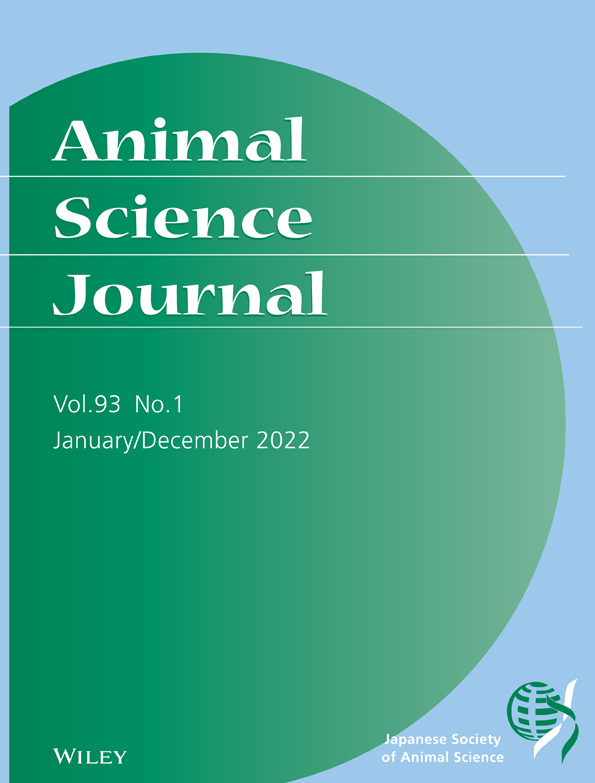Reduction of the occurrence of incorrect stunning and the occurrence of reflexes and reactions in cattle after pneumatically powered captive-bolt stunning in comparison with cartridge-fired captive-bolt stunning
Abstract
In this study, the occurrence of repeat stunning, deviations in placement and direction of stun shots, and the occurrence of reflexes/reactions following stunning with a pneumatically powered captive-bolt stunner in comparison with a cartridge-fired captive-bolt stunner in cattle were assessed. Repeat stunning and deviations in placement and direction of the stun shots were less frequent (p < 0.01) with the use of a pneumatic stunner in all cattle. The rate of repeat stunning and deviation from the ideal place and direction of stun shots were lower (5.81%, 24.75%, and 9.60% of all animals, respectively) when a pneumatic stunner was used in comparison with cartridge-fired captive bolt (18.32%, 34.03%, and 47.38% of all animals, respectively). The stunning quality was assessed on the basis of evaluation of signs observed following the stun shot. A pneumatic stunning resulted in a significant reduction of occurrence of signs particularly in bulls in comparison to cows, for which a cartridge-fired stunner already provides an adequate stunning. Our study provides evidence that pneumatic stunning has the potential to be a more effective method than cartridge-fired stunning from the viewpoint of the welfare of slaughtered animals. Pneumatic stunning ensures a high quality of stunning in both bulls and cows.
1 INTRODUCTION
Livestock animals should be slaughtered at abattoirs without experiencing unnecessary pain, stress, or suffering. The requirements of methods of stunning are laid out in the European legislation (European Union, 2009). Effective stunning that puts the animal into a state of deep unconsciousness is a necessary precondition to all slaughter, with the exception of cases of ritual slaughter (Terlouw et al., 2015).
Loss of consciousness is defined as a state of temporary or permanent loss of the functions of the brain. The activity of the neurons in the brain is disrupted during stunning as a result of the shock wave caused by the projectile when it hits the skull. The penetration of the bolt (projectile) into the cranial cavity leads to damage to brain structures and subsequent bleeding into the brain (Gibson et al., 2015; Terlouw et al., 2015). The damage to the brain tissue is magnified both by the pressure caused by bleeding itself and by the empty space left by the projectile and leads to disruption to surrounding structures (Gibson et al., 2012). Atkinson et al. (2013) further reported that the effectiveness of stunning is determined by the nature and type of the stunning device used. The selection of stunning device is conditional to the weight and category of animal (von Holleben et al., 2018). The penetrating captive-bolt device is the most widespread equipment used to stun cattle around the world (Terlouw et al., 2015, 2016a). The aim of the projectile when it penetrates the cranial cavity is to impact the brainstem, as the reticular formation, which influences wakefulness and consciousness, is located within the brainstem (Finnie, 2001; Terlouw et al., 2016a). The shot site has a great influence on the intended brain damage. Fries et al. (2012) found that stunning is effective if the device is held to the center of the forehead (ideal place for stunning), to optimize the probability to produce damage to the brainstem. In case of using cartridge-fired captive-bolt devices, the prevalence of a shallow depth of unconsciousness has ranged from 4% to 15% in the published studies (Gregory et al., 2007; Kamenik et al., 2019; von Wenzlawowicz et al., 2012). The risk of shallow depth of unconsciousness increases with increasing deviation from the ideal shot site (Vecerek, Kamenik, Voslarova, Vecerkova, et al., 2020; Vecerek, Kamenik, Voslarova, Volfova, et al., 2020). Another device used on cattle is the pneumatically powered captive-bolt device, which is used primarily in high-capacity abattoirs (Oliveira et al., 2017). According to Dorfler et al. (2013), it is more effective than the traditional stunning device. The potentially good effectiveness of pneumatic stunning has also been confirmed by von Holleben et al. (2018). Von Wenzlawowicz et al. (2012), however, drew attention to the fact that it may be difficult to direct the shot precisely with a pneumatic stunning device. In their study, in only 34.7% of the animals, the stunning position was correct.
The aim of this study was to assess the occurrence of repeat stunning, the occurrence of deviations in placement and direction of the stun shots, and the occurrence of signs in cattle after pneumatic stunning in comparison with stunning with a cartridge-fired captive bolt. Furthermore, the differences between stunning of bulls and cows were evaluated.
2 MATERIALS AND METHODS
2.1 Ethics statement
This study was carried out in strict accordance with the Directive 2010/63/EU of the European Parliament and of the Council of 22 September 2010 on the protection of animals used for scientific purposes and Czech national legislation, that is, Act No. 246/1992 Coll., on the protection of animals against cruelty, as amended. The data on the occurrence of reflexes/reactions in cattle following stunning with a pneumatically powered captive-bolt and cartridge-fired captive-bolt devices at the abattoirs were obtained solely by observation; the data on placement and direction of the stun shots were obtained post mortem. Since the animals did not undergo any experimental procedures and no handling of animals related to research was carried out, an exemption petition was filed and granted with the Animal Welfare Body of the University of Veterinary Sciences Brno having regard to the EU Directive 2010/63/EU. Stunning and slaughter of animals were carried out in approved establishments and in accordance with standard operating procedures as required by the Council Regulation (EC) No. 1099/2009.
2.2 Animals and stunning methods
The two stunning methods studied were evaluated at the same abattoir. Each method was evaluated separately on 2 days on which cattle stunning was performed by the same three workers. The first slaughterman was responsible for shooting and stunning of cattle. The second slaughterman carried out hoisting and sticking of stunned animals, and the third slaughterman was responsible for bleeding. All three slaughtermen were considered qualified and experienced at the same level. They switched their positions regularly, and thus, the same proportion of animals included in the study had been stunned by each of them. In both trials, mostly Holstein cows, beef simmental, and charolais bulls were slaughtered. All slaughtered bulls were of beef breeds (beef simmental and charolais bulls), while majority (84%) of slaughtered cows and heifers were culled animals from dairy industry (i.e., dairy breeds, viz., Holstein). Cartridge-fired captive-bolt stunning of cattle at the abattoir was evaluated on 382 cattle heads: 166 bulls (aged between 13 and 60 months, average age: 23 months) and 216 cows and heifers (aged between 13 and 130 months, average age: 51.7 months). Cartridge-fired captive-bolt stunning was performed using a device in which the captive bolt (steel tip), when fired from the stunning pistol, penetrates the skull at the site at which it is placed to the skull and penetrates the brain to the depth of the bolt (steel tip). It causes mechanical damage at the shot site to the meninges and brain tissue. Specifically, a Matador SS 3000 B trigger-activated captive-bolt gun (Termet) using caliber 6.3/12 red explosive cartridges (powder content in cartridge 320 mg) intended for all animals over 450 kg (bulls, young cattle, cows, and heifers) was used.
Pneumatic stunning was studied at the same abattoir on 396 cattle heads: 143 bulls (aged between 8 and 28 months, average age: 21.5 months) and 253 cows and heifers (aged between 8 and 168 months, average age: 63 months). Pneumatic stunning was performed with a device in which the captive bolt (steel tip) is fired by compressed air. The bolt penetrates the skull at the site at which the stunning pistol is placed to the skull, and the compressed air is also forced through the opening into the skull and causes mechanical damage to the meninges and brain tissue both at the shot site and in the area surrounding the shot site. A STUN-BP1 pneumatic bolt stunner (Freund, Germany) intended for stunning adult cattle, calves, and equine animals in large plants (capacity > 500 animals per week) was used. The stunning device uses a pressure of 14 bar.
2.3 Number, placement, and direction of the stun shots
The number of stun shots needed to achieve the collapse of the animal and its motor paralysis was monitored during stunning at the abattoir, and the number of animals for which more than one stun shot was used was recorded (repeat stunning).
Subsequently, the distance of the stun shot (the hole left by the stun shot) from the ideal point for the stun shot (deviation from ideal place) on the skull and the deviation in the direction of the stun shot from the ideal angle of 90° were determined post mortem. The ideal point is defined differently by different authors. According to Grandin (2019), the ideal point for stunning cattle is at the intersection of two diagonal lines between the base of each horn and the contralateral eye. A stun shot 2.5 cm above this point is also effective. A higher position, that is, 5 cm above this intersection, is advised for longer faced cattle. According to Gilliam et al. (2016), the ideal place is at a point halfway on a midline perpendicular to horizontal lines drawn over the top of the poll and between the lateral canthus of each eye. This confirms the finding of Grandin (2019) that at least in certain cases, an entry point slightly above the intersection between diagonal lines is more efficient. For the purposes of our study, the ideal point was defined according to the Czech law, namely, Decree No. 418/2012 Coll., on the protection of animals at the time of killing, as amended (Czech Republic, 2012), which recommends the same entry point as Gilliam et al. (2016) (Figure 1). The deviation from the ideal point was measured using a transparent mask. One mask was used to identify the ideal point (Figure 2); the second mask was used to measure the deviation from the ideal point (Figure 3). The center of the concentric circles was positioned on the point that was considered to be ideal for a stun shot; a distance from the ideal point was measured by the method of concentric circles. The placement of the stun shot at a distance of more than 3 cm from the ideal point was considered an error in the stunning process (deviation in placement of stunning shot). This value was based on the results of the previous study (Vecerek, Kamenik, Voslarova, Volfova, et al., 2020) showing that almost all cattle shots within 3 cm of the ideal point were rendered unconscious. The angle of the shot was measured using a method described by Fries et al. (2012). Any deviation from the ideal angle of more than 5° was considered an error in the stunning process. The value of 5° considers that the placement of the stunning device at 90° can be easily respected and that greater deviations would deport the tip of the bolt away from the target (if a bolt of 10 cm is used, a deviation of 5° deports the tip over 0.87 cm). The placement of the stun shot and the deviation in the direction of the stun shot were evaluated after decapitation and skinning of slaughtered animals. The skull of each animal was assessed with horns (all animals were horned).

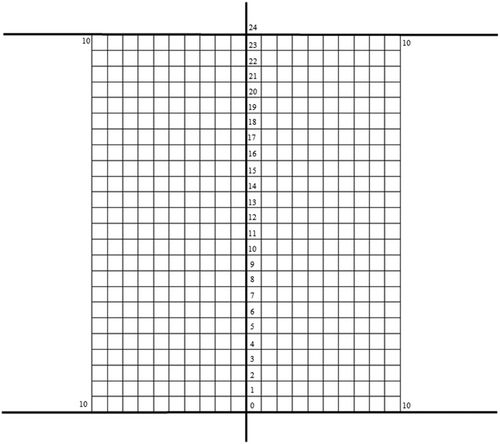
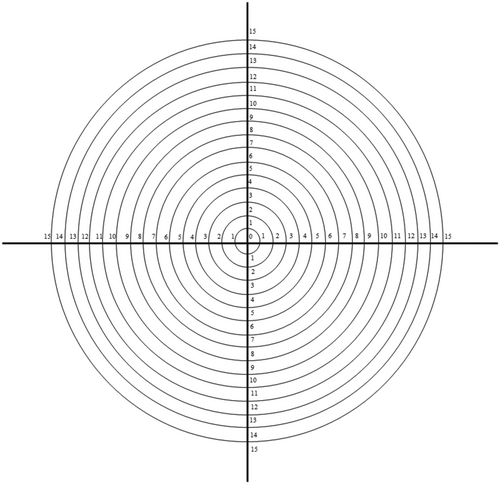
The occurrence of repeat stunning and the occurrence of deviations in placement and direction of the stun shot was compared between cattle stunned with the cartridge-fired captive-bolt and pneumatically powered captive-bolt devices. A comparison between cartridge-fired captive-bolt stunning and pneumatic stunning was performed for total cattle and then separately for bulls and for cows and heifers (hereafter in the text merely cows).
Evaluation of the number, placement, and direction of the stun shots made by the cartridge-fired captive-bolt and pneumatically powered captive-bolt devices was performed by the same three observers (veterinarians) who also assessed the reactions and reflexes following stunning.
2.4 Reactions and reflexes after stunning
The occurrence of reactions and reflexes after stunning was evaluated on the basis of observation of each animal at the abattoir following the stun shot. Three observers (veterinarians) stood behind the stunning pen and, after the gun was fired, recorded the presence of signs (Table 1) occurring in the stunning box, on the landing roast, and on the shackle line, namely, the occurrence of attempt to regain posture, the occurrence of a corneal reflex, the occurrence of a response to painful stimuli, the occurrence of rhythmic breathing, the occurrence of spontaneous blinking, the occurrence of species-specific vocalization, the occurrence of eyeball rotation, and the occurrence of nystagmus following stunning. Animals were considered correctly stunned if they showed simultaneously the three signs of unconsciousness: instantaneous and permanent loss of standing posture without righting reflexes, the absence of a corneal reflex, and the absence of rhythmic breathing (Table 1) until the end of bleeding. The occurrence of reactions and reflexes was observed both for animals stunned with the cartridge-fired captive-bolt and for animals stunned with the pneumatically powered captive-bolt devices.
| Sign | Description | Reference | |
|---|---|---|---|
| Signs of consciousness | |||
| Attempt to regain posture | The occurrence of an effort to stand up or lift the head before hoisting. | Atkinson et al. (2013) Terlouw et al. (2016b) |
|
| Corneal reflex | The corneal reflex is tested by lightly touching the cornea: If the reflex is present, the eyelid closes. | Terlouw (2020) | |
| Response to painful stimuli | The occurrence of a response to painful stimuli (withdrawal) caused by a prick to the inner skin of the nostril. | Terlouw et al. (2016b) | |
| Species-specific vocalization | The occurrence of repeated vocalizations and groans which are not connected with a one-time exhalation. | Verhoeven et al. (2015) | |
| Signs of risk of consciousness or of return of consciousness | |||
| Eyeball rotation | The occurrence of rolling of eyeballs. | Terlouw et al. (2016b) Gregory et al. (2007) |
|
| Nystagmus | The occurrence of rapid eyeball movements from side to side. | Terlouw et al. (2016b) Atkinson et al. (2013) |
|
| Rhythmic breathing | The occurrence of rhythmic inhalation and exhalation following the stun shot. | Verhoeven et al. (2015) Atkinson et al. (2013) |
|
| Spontaneous blinking | The occurrence of unstimulated opening/closing eyelid. | Terlouw et al. (2016b) | |
| Signs of unconsciousness | |||
| Instantaneous and permanent loss of standing posture without righting reflexes | The animal is definitely unconscious when it permanently loses the ability to stand. Coordinated and oriented righting reflexes must be absent after stunning. | Grandin (2020) Terlouw (2020) |
|
| Absence of a corneal reflex | There is an absence of closing of the eyelids after touching the cornea. | Terlouw (2020) | |
| Absence of rhythmic breathing | Rhytmic breathing is not present. | Terlouw (2020) | |
2.5 Statistical analysis
The data were analyzed using the statistical package Unistat v. 6.5. (Unistat Ltd., London, England). For the purposes of statistical comparison of the frequency of occurrence of repeat stunning, the occurrence of deviations in placement and direction of the stun shot and the occurrence of reflexes/reactions, a Chi-square test was used to assess statistical significance in a 2 × 2 contingency table. Yates' correction was used on frequencies exceeding 5, while Fisher's exact test was used at frequencies lower than 5 (Zar, 1999). A value of p < 0.05 was considered statistically significant.
3 RESULTS
The occurrence of repeat stunning, deviation in placement and direction of the stun shot, and the presence of signs following the stun shot by a cartridge-fired captive-bolt stunner and a pneumatically powered captive-bolt stunner in cattle is shown in Tables 2 and 3. The results (Figure 4) show that overall statistically highly significantly lower values (p ˂ 0.01) were determined for pneumatic stunning than for cartridge-fired stunning, that is, that pneumatic stunning reduced the occurrence of repeat stunning and also the number of shots outside the 3 cm circle (deviation in placement of the stun shot) and the number of shots with deviation more than 5° from the ideal angle (deviation in direction of the stun shot). Statistically significantly (p ˂ 0.05) lower values for all monitored indices were found in bulls. In cows, statistically significantly (p ˂ 0.001) lower values were found for the number of shots with angle deviations. Overall, the pneumatic stunning reduced the occurrence of repeat stunning and deviation in placement and direction of the stun shots in comparison with cartridge-fired stunning.
| Sign | Bulls (n = 166) | Cows (n = 216) | Total (n = 382) | |||
|---|---|---|---|---|---|---|
| Number | % | Number | % | Number | % | |
| Repeat stunning | 54 | 32.53 | 16 | 7.41 | 70 | 18.32 |
Stun shot outside the circle (r = 3 cm) |
54 | 32.53 | 76 | 35.19 | 130 | 34.03 |
Deviation from the ideal angle (>5°) |
98 | 59.04 | 83 | 38.43 | 181 | 47.38 |
| Attempt to regain posture | 5 | 3.01 | 9 | 4.17 | 14 | 3.66 |
| Corneal reflex | 15 | 9.04 | 8 | 3.70 | 23 | 6.02 |
| Response to painful stimuli | 5 | 3.01 | 4 | 1.85 | 9 | 2.36 |
| Rhythmic breathing | 20 | 12.05 | 2 | 0.93 | 22 | 5.76 |
| Spontaneous blinking | 27 | 16.27 | 3 | 1.39 | 30 | 7.85 |
| Species-specific vocalization | 3 | 1.81 | 0 | - | 3 | 0.79 |
| Eyeball rotation | 58 | 34.94 | 4 | 1.85 | 62 | 16.23 |
| Nystagmus | 41 | 24.70 | 19 | 8.80 | 60 | 15.71 |
| Sign | Bulls (n = 143) | Cows (n = 253) | Total (n = 396) | |||
|---|---|---|---|---|---|---|
| Number | % | Number | % | Number | % | |
| Repeat stunning | 9 | 6.29 | 14 | 5.53 | 23 | 5.81 |
Stun shot outside the circle (r = 3 cm) |
30 | 20.98 | 68 | 26.88 | 98 | 24.75 |
Deviation from the ideal angle (>5°) |
15 | 10.49 | 23 | 9.09 | 38 | 9.60 |
| Attempt to regain posture | 0 | - | 4 | 1.58 | 4 | 1.01 |
| Corneal reflex | 0 | - | 1 | 0.40 | 1 | 0.25 |
| Response to painful stimuli | 0 | - | 1 | 0.40 | 1 | 0.25 |
| Rhythmic breathing | 0 | - | 1 | 0.40 | 1 | 0.25 |
| Spontaneous blinking | 3 | 2.10 | 1 | 0.40 | 4 | 1.01 |
| Species-specific vocalization | 0 | - | 0 | - | 0 | - |
| Eyeball rotation | 10 | 6.99 | 6 | 2.37 | 16 | 4.04 |
| Nystagmus | 3 | 2.10 | 0 | - | 3 | 0.76 |
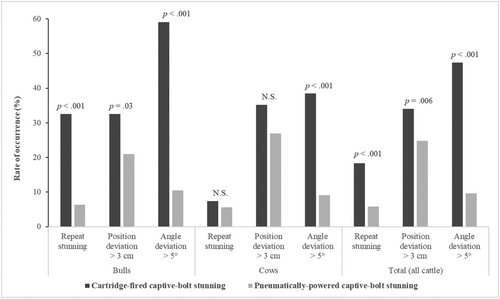
A statistically highly significantly (p ˂ 0.001) larger number of stun shots and number of shots with angle deviation were found in bulls than in cows with the use of a cartridge-fired stunner (Figure 5). Statistically significant differences between bulls and cows were not demonstrated (p > 0.05) in the case of pneumatic stunning.
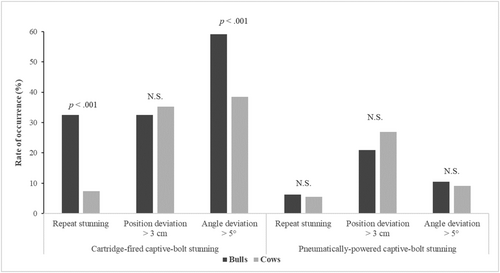
Lower values were found for all signs across all cattle after the stun shot with a pneumatically powered captive-bolt stunner than with a cartridge-fired captive-bolt stunner (Figure 6); this was statistically highly significant for all signs (p ˂ 0.01) with the exception of species-specific vocalization, for which the value achieved with a cartridge-fired stunner was already very low (0.79%) and fell to zero with a pneumatic stunner. For total cattle, pneumatic stunning significantly reduced the occurrence of signs after the stun shot in comparison with cartridge-fired stunning.
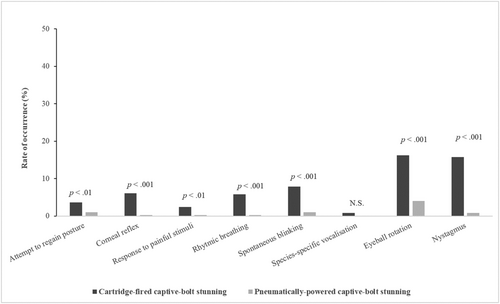
In bulls, a lower occurrence was found for all signs recorded after the stun shot made by a pneumatically powered captive-bolt stunner in comparison with cartridge-fired stunning (Figure 7), with this reduction being statistically significant (p ˂ 0.05) with the exception of the occurrence of species-specific vocalization (p > 0.05). Furthermore, of all the monitored signs, only spontaneous blinking (2.10%), eyeball rotation (6.99%), and nystagmus (2.10%) were observed.
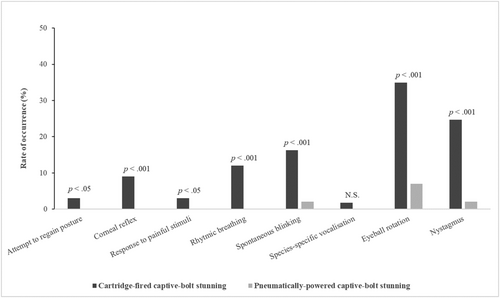
In cows, values <2% were found for all signs recorded after the stun shot made by a pneumatically powered captive-bolt stunner (Figure 8) with the exception of eyeball rotation (2.37%). However, the statistical (p ˂ 0.01) differences between cartridge-fired and pneumatically powered captive-bolt stunners were manifested only in corneal reflex (3.70%; 0.40%) and nystagmus (8.80%; 0%).
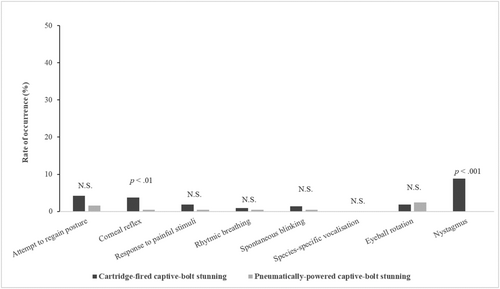
4 DISCUSSION
4.1 Repeat stunning
The results showed differences in the number of shots needed before the animal collapsed between cartridge-fired captive-bolt stunning and pneumatically powered captive-bolt stunning. The occurrence of more than one stun shot may be considered as an indicator of ineffective stunning. The rate of repeat stunning was higher with the cartridge-fired stunning device; more than one stun shot was used in 18.32% of all animals. Similarly, using a cartridge-fired captive bolt stunner, Atkinson et al. (2013) reported repeat stunning in 12.4% of cattle, while Fries et al. (2012) recorded repeat stunning in approximately 3% of slaughtered animals. In contrast, von Holleben et al. (2018) recorded no repeat stunning when pneumatically powered captive-bolt stunning was used in cattle. In our study, the use of a pneumatic stunner did not remove repeat stunning completely but reduced it significantly in comparison to cartridge-fired captive-bolt stunning (5.81% and 18.32%, respectively). However, when the number of repeat stunning is evaluated, other factors must also be considered. A second shot may also be conditioned by an uncertainty regarding correct stunning on the part of the staff. In our study, both stunning devices were used by the same slaughtermen. Thus, the results suggest that in their case, the use of a pneumatic stunner did reduce the occurrence of repeat stunning.
Stunning efficiency is influenced also by the nature and type of the stunning device used (Atkinson et al., 2013) but also by animals (their thickness of skull) (Gouveia et al., 2009). Gouveia et al. (2009) reported that the effectiveness of stunning was just 68.2% with the use of a cartridge-fired captive-bolt device. For loss of consciousness, the penetration of the projectile into the cranial cavity which leads to the damage of brain structure is essential (Gibson et al., 2015). Inappropriate cartridge size in cartridge-fired captive-bolt devices leads to insufficient force to penetrate the skull. That may be the reason of lower effectiveness of this device. The most common cause of stunning failure is the insufficient power of the cartridge that does not enable penetration of the more massive skulls of bulls (Gregory et al., 2007). On the other hand, the advantage of pneumatic stunning device is its high pressure power source ensuring the penetration of projectile into the skull. Pneumatic stunning device is much more efficient in changing potential energy into kinetic energy than a cartridge-fired captive-bolt device—due to high pressure (Dorfler et al., 2013). This may explain higher effectivity of stunning expressed by lower frequency of repeat shots in case of utilization of this device found in our study.
4.2 Deviations in placement and direction of the stun shots
We also evaluated the precision of the shot site in both stunning methods. Our results showed that, from the viewpoint of deviations of stun shots, pneumatically powered captive-bolt stunning markedly reduced the occurrence of shots outside a circle of a diameter of 3 cm (24.75% vs. 34.03%) and the number of shots at an angle deviated by more than 5° (9.60% vs. 47.38%) in comparison with cartridge-fired captive-bolt stunning. A high percentage of shots outside the optimal shot site when a cartridge-fired captive bolt was used was also detected by Vecerek, Kamenik, Voslarova, Volfova, et al. (2020). In their study, less than a half of animals (46.9%) had a shot hole within a 3 cm circle around the ideal spot. Precision of the stun shot may be affected by the human factor. The workload at the abattoir and the level of supervision should be monitored. The possible effect of the operator was not evaluated in our study. However, since both stunning devices were operated by the same slaughtermen, the reduction of deviations in shot position and direction resulted more likely from the change of the stunning device than from the change in the operator's skills. Another reason for deviations in placement of stun shots may be the inadequate restraint of the animal during stunning. Unrestricted movement of the head in the stunning box may be a cause for stunning failure (Bourguet et al., 2011). The use of head restrainer can ensure the correct direction of the shot (von Holleben et al., 2018).
Our results showed that it was much more difficult to achieve the ideal shot angle during cartridge-fired stunning in comparison with pneumatic stunning (47.38% vs. 9.60%). Council Regulation (EC) No. 1099/2009 (European Union, 2009) requires the restriction of the head of the animal in the stunning box, making lateral and vertical movements impossible, if a pneumatic stunning device is used. This requirement is not laid down in the legislation in the case of cartridge-fired captive-bolt devices. This may also be the reason why so many shots with a cartridge-fired captive bolt in our study deviated from an ideal angle.
The results of our study confirm differences in precision of stunning shots between the two methods used. Results indicate that the type of the stunning device may influence the precision when aiming the device, which is of great importance for questions related to animal welfare at slaughter (Gilliam et al., 2012; Vecerek, Kamenik, Voslarova, Volfova, et al., 2020).
4.3 Reactions and reflexes after stunning
Indicators of consciousness represent tools to assess indirectly the state of brain function (Terlouw et al., 2016b). Signs such as an attempt to regain posture (including coordinated head righting with or without a body righting reflex), corneal reflex, response to painful stimuli, and species-specific vocalization are used to evaluate the quality of stunning. These signs reflect the activity of the brainstem and the behavior of the individual and represent the signs of consciousness (Grandin, 2013; Terlouw, 2020; Terlouw et al., 2016b; Verhoeven et al., 2015). Other signs including eyeball rotation, nystagmus, rhythmic breathing, and spontaneous blinking immediately after shooting may indicate that there is a risk of consciousness or risk of return of consciousness (Grandin, 2002; Gregory et al., 2007; Terlouw, 2020; Terlouw et al., 2016b). The quality of stunning may then be assessed on the basis of observation of selected reflexes and reactions. Following frontal captive bolt stunning, the instantaneous and permanent loss of standing posture without righting reflexes, the absence of a corneal reflex and the absence of rhythmic breathing indicate a state of unconsciousness and hence a correct quality of the stun (Terlouw, 2020).
The results of our study showed that the use of pneumatically powered captive-bolt significantly reduced the occurrence of monitored signs of consciousness as well as signs of risk of consciousness or risk of return of consciousness in cattle in comparison to cattle stunned with the cartridge-fired captive-bolt device. The low occurrence of monitored signs following stunning with a pneumatically powered stunning device (˂5%) is positive from the perspective of welfare of slaughtered animals and confirms the efficiency of this device.
4.4 Effect of gender
Our results showed that the occurrence of repeat stunning in bulls was significantly higher (32.53%) than in cows (7.41%) in case of the use of a cartridge-fired stunning device. Repeat stunning was also recorded more frequently in bulls than in cows and heifers in other studies (Atkinson et al., 2013; Dorfler et al., 2013; Terlouw et al., 2015). Gouveia et al. (2009) reported that differences may also be found between utility classes of cattle, with stunning being less effective in beef cattle. This may be associated with the shaping of the skull. The thickness and size of the skull are another factor, in addition to gender, influencing the effectiveness of stunning and subsequent damage to brain structures (Gregory et al., 2007; Terlouw et al., 2015). Predominance of beef bulls and predominance of dairy cows could also have an impact on the differences in the occurrence of the repeat stunning between bulls and cows found in our study.
However, no difference in the occurrence of repeat stunning between bulls and cows was found in our study in case of the use of a pneumatically powered captive-bolt stunning device. It was caused mainly by a pronounced fall in the occurrence of repeat stunning in bulls (6.29% vs. 32.53%). The rate of repeat stunning was already low in cows with the use of cartridge-fired stunning, for which reason the difference with pneumatic stunning was not so pronounced (5.53% vs. 7.41%). Evaluation of the effect of gender on the occurrence of repeat stunning showed that the use of a cartridge-fired stunning device was less effective in bulls than it was in cows. The introduction of the pneumatic stunning device has led to a pronounced reduction in the rate of repeat stunning in bulls. The results suggest that more effective stunning can be achieved with a pneumatically powered stunning device than with a cartridge-fired stunning device, particularly in bulls.
No differences between bulls and cows were found in the precision of the placement of the stun shot in any of the two stunning methods evaluated in our study. No differences in the deviations from the ideal shot site between bulls and cows were found also by Terlouw et al. (2015), who monitored deviations in the localization of the shot during cartridge-fired stunning.
In the case of cartridge-fired stunning, signs following the stun shot were recorded more frequently in bulls than in cows. Signs of consciousness as well as signs of risk of consciousness were observed more frequently in bulls than in cows with the exception of attempts to regain a normal posture, which were detected more frequently in cows than in bulls. A similar conclusion was reached by Atkinson et al. (2013), who also detected signs following stunning to a greater extent in bulls (13.6%) than in other cattle (3.8%). Both Terlouw et al. (2015) and Gregory et al. (2007) further reported that breathing and corneal reflexes were more common in bulls than in cows. Correspondingly in our study, rhythmic breathing and spontaneous blinking were detected in only few cases in cows, while they were seen in higher frequencies in slaughtered bulls. The more frequent occurrence of selected signs in bulls has also been reported by Vecerek, Kamenik, Voslarova, Vecerkova, et al. (2020).
When a pneumatically powered stunning device was used, occurrence of signs of consciousness and also signs of risk of consciousness was reduced. A pronounced fall in the signs present was particularly evident in bulls. On the other hand, the differences observed in cows between the pneumatically powered and cartridge-fired stunning devices were manifested only in corneal reflex and nystagmus.
In conclusion, the stunning method used during slaughter at the abattoir has a fundamental effect on the welfare of the slaughtered animals. The number of repeat shots and precision of shot position and direction as well as absence of signs of consciousness after the animal is shot belong among key indicators used to assess stunning quality and efficiency. The results of our study show that a pneumatically powered stunning device has potential to be a more effective method than a cartridge-fired stunner and may ensure the successful stunning of cattle with a high level of certainty. The application of the pneumatic stunning device in everyday practice at cattle abattoirs is extremely positive from the viewpoint of the welfare of the animals slaughtered.
ACKNOWLEDGMENTS
We thank the slaughterhouse operator for allowing us to perform the study and the anonymous reviewers for their constructive input.
CONFLICT OF INTEREST
The authors declare no conflict of interest for this article.



